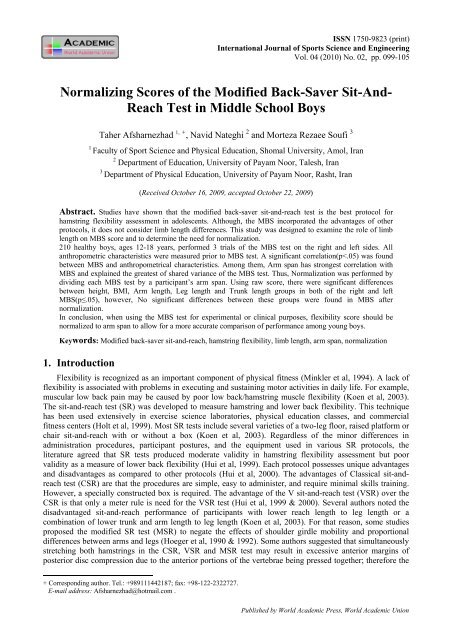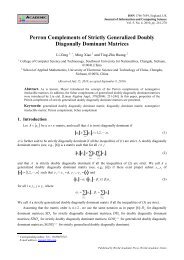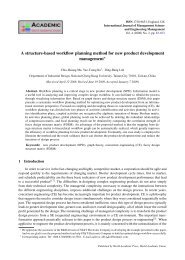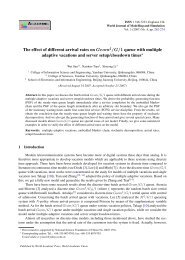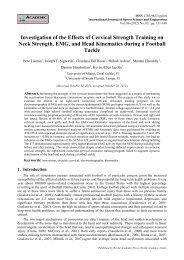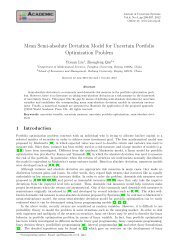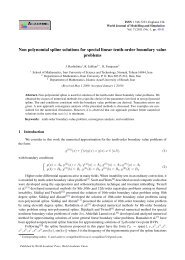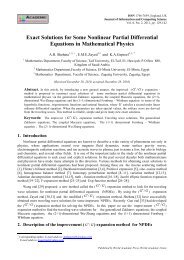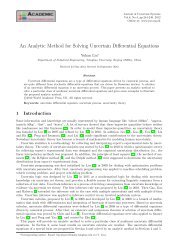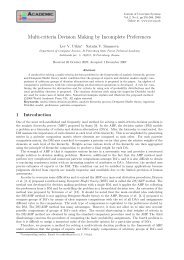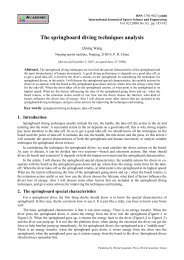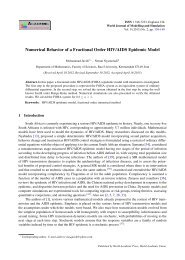Normalizing Scores of the Modified Back-Saver Sit-And-Reach Test ...
Normalizing Scores of the Modified Back-Saver Sit-And-Reach Test ...
Normalizing Scores of the Modified Back-Saver Sit-And-Reach Test ...
You also want an ePaper? Increase the reach of your titles
YUMPU automatically turns print PDFs into web optimized ePapers that Google loves.
ISSN 1750-9823 (print)<br />
International Journal <strong>of</strong> Sports Science and Engineering<br />
Vol. 04 (2010) No. 02, pp. 099-105<br />
<strong>Normalizing</strong> <strong>Scores</strong> <strong>of</strong> <strong>the</strong> <strong>Modified</strong> <strong>Back</strong>-<strong>Saver</strong> <strong>Sit</strong>-<strong>And</strong>-<br />
<strong>Reach</strong> <strong>Test</strong> in Middle School Boys<br />
Taher Afsharnezhad 1, , Navid Nateghi 2 and Morteza Rezaee Soufi 3<br />
1<br />
Faculty <strong>of</strong> Sport Science and Physical Education, Shomal University, Amol, Iran<br />
2 Department <strong>of</strong> Education, University <strong>of</strong> Payam Noor, Talesh, Iran<br />
3<br />
Department <strong>of</strong> Physical Education, University <strong>of</strong> Payam Noor, Rasht, Iran<br />
(Received October 16, 2009, accepted October 22, 2009)<br />
Abstract. Studies have shown that <strong>the</strong> modified back-saver sit-and-reach test is <strong>the</strong> best protocol for<br />
hamstring flexibility assessment in adolescents. Although, <strong>the</strong> MBS incorporated <strong>the</strong> advantages <strong>of</strong> o<strong>the</strong>r<br />
protocols, it does not consider limb length differences. This study was designed to examine <strong>the</strong> role <strong>of</strong> limb<br />
length on MBS score and to determine <strong>the</strong> need for normalization.<br />
210 healthy boys, ages 12-18 years, performed 3 trials <strong>of</strong> <strong>the</strong> MBS test on <strong>the</strong> right and left sides. All<br />
anthropometric characteristics were measured prior to MBS test. A significant correlation(p
100<br />
Taher Afsharnezhad, et al: <strong>Normalizing</strong> <strong>Scores</strong> <strong>of</strong> <strong>the</strong> <strong>Modified</strong> <strong>Back</strong>-<strong>Saver</strong> <strong>Sit</strong>-<strong>And</strong>-<strong>Reach</strong> <strong>Test</strong> in Middle School Boys<br />
<strong>Back</strong>-saver sit-and-reach test (BS) was proposed (Cailliet-1988; Hui et al, 1999). The BS test evaluates only<br />
one leg at a time and requires a sit-and-reach box (Hui et al, 1999 & 2000). However, <strong>the</strong> investigators <strong>of</strong>ten<br />
received complaints from participants about <strong>the</strong> uncomfortable position <strong>of</strong> <strong>the</strong> untested leg. For this reason, a<br />
modified version <strong>of</strong> <strong>the</strong> BS is proposed by <strong>the</strong> investigators. <strong>Modified</strong> <strong>Back</strong>-saver sit-and-reach test (MBS)<br />
incorporated <strong>the</strong> advantages <strong>of</strong> <strong>the</strong> VSR and BS.<br />
Often test administrator desires to select a test that allows greatest validity and reliability, with <strong>the</strong> least<br />
equipment and preparation time, and produce <strong>the</strong> least discomfort to subjects (Hui et al, 2000). The MBS test<br />
adopts <strong>the</strong> notion <strong>of</strong> single leg stretch, which eliminates <strong>the</strong> excessive posterior disk compression <strong>of</strong> <strong>the</strong><br />
vertebrae (Baltaci et al, 2003) and requires only a measuring rule and a bench, which can be easily prepared<br />
in most school settings. It is a practical test that requires minimal preparation time and equipment and<br />
without <strong>the</strong> use <strong>of</strong> a box. Moreover, <strong>the</strong> specific posture when performing <strong>the</strong> test eliminates <strong>the</strong> abnormal<br />
position and discomfort feeling <strong>of</strong> <strong>the</strong> unstretched leg, as in <strong>the</strong> BS test. Fur<strong>the</strong>rmore, a teacher might be able<br />
to detect some difference in hamstring flexibility from limb to limb that would be hidden in testing with <strong>the</strong><br />
traditional SR test. This would allow feedback and potential exercises to correct any imbalances that<br />
o<strong>the</strong>rwise may lead to potential injury or postural disturbance.<br />
For all <strong>the</strong> advantages <strong>of</strong> this protocol, MBS test can not eliminate <strong>the</strong> effects <strong>of</strong> shoulder girdle mobility<br />
and proportional differences between arms and legs. There have been some studies into <strong>the</strong> relation between<br />
flexibility as measured by <strong>the</strong> CSR test and anthropometric measures. Some authors have questioned <strong>the</strong><br />
validity <strong>of</strong> <strong>the</strong> CSR test, suggesting that <strong>the</strong>re is an advantage for an individual with a long trunk, long arms,<br />
and short legs (Hoeger et al, 1990 & 1992). However a study has not confirmed this claim (Holt et al, 1999).<br />
Hoeger et al suggested that <strong>the</strong> CSR does not control <strong>the</strong> possible limb-length biases. They indicated that <strong>the</strong><br />
MSR eliminates concern about disproportionate limb length bias and appeared to be a better test (Hoeger et<br />
al, 1990 & 1992).<br />
We hypo<strong>the</strong>sized that <strong>the</strong> result <strong>of</strong> MBS test should be normalized by anthropometrical measures.<br />
Therefore, this study was designed to examine <strong>the</strong> role <strong>of</strong> <strong>Sit</strong>ting height, Arm length, Trunk length, leg<br />
length, Arm span, and Sum <strong>of</strong> trunk and arm lengths on MBS test and to determine <strong>the</strong> need for<br />
normalization <strong>of</strong> performance data.<br />
2. Methods<br />
2.1. Participants<br />
210 healthy boys, ages 12-18 years, without known impairment <strong>of</strong> <strong>the</strong> musculoskeletal system affecting<br />
<strong>the</strong> spine or <strong>the</strong> lower extremities, volunteered to participate in this study (body mass 57.1±12.4 kg, height<br />
166.4±10.8 cm, age 15.4±1.3 yr, BMI 19.7±2.8 kg/m2; M±SD). All subjects were students in secondary<br />
schools. The subjects were carefully informed about <strong>the</strong> design <strong>of</strong> <strong>the</strong> study with special information on<br />
possible discomfort and benefit that might result, and subsequently signed an informed consent form prior to<br />
<strong>the</strong> start <strong>of</strong> <strong>the</strong> study. The Shomal University Institutional Review Board for Human Investigation approved<br />
all experimental procedures.<br />
2.2. Predictive Factors<br />
Standing height was measured by used <strong>the</strong> stretch stature method. The participant stood with <strong>the</strong> feet<br />
toge<strong>the</strong>r without shoes, looked straight ahead and inhaled while <strong>the</strong> measurement was taken. Stature is <strong>the</strong><br />
maximum distance between <strong>the</strong> floor and <strong>the</strong> vertex <strong>of</strong> <strong>the</strong> head. <strong>Sit</strong>ting height was <strong>the</strong> maximum distance<br />
from <strong>the</strong> vertex to <strong>the</strong> base <strong>of</strong> <strong>the</strong> sitting surface when <strong>the</strong> back and neck were straight and in normal state.<br />
Cervical height sitting is occasionally used to estimate trunk length excluding <strong>the</strong> neck and head (Lohman et<br />
al,1988). Body mass was determined with digital scales (Seca 770, Hamburg, Germany) that had a<br />
measurement resolution <strong>of</strong> 0.1 kg. Arm length was determined first by locating <strong>the</strong> Acromion <strong>of</strong> <strong>the</strong> scapula<br />
by palpation. The most lateral point on <strong>the</strong> end <strong>of</strong> <strong>the</strong> acromial process <strong>of</strong> <strong>the</strong> shoulder blade was marked<br />
with a pen and <strong>the</strong> arm length was recorded as distance from this point to <strong>the</strong> middle fingertip with <strong>the</strong> arm<br />
extended and held parallel to <strong>the</strong> floor. Arm span was measured when <strong>the</strong> arms abducted to 90 degrees,<br />
elbows extended, forearms supinated, with <strong>the</strong> wrist in neutral, and fingers extended. Arm span is <strong>the</strong><br />
distance between <strong>the</strong> tips <strong>of</strong> <strong>the</strong> middle fingers <strong>of</strong> each hand when both arms are extended laterally and<br />
maximally to <strong>the</strong> level <strong>of</strong> <strong>the</strong> shoulder (Lohman et al, 1988). Leg length was calculated as <strong>the</strong> difference<br />
between standing and <strong>Sit</strong>ting height (Wadsworth et al, 2002). As a new variable, Sum <strong>of</strong> trunk and arm<br />
length was calculated to improve prediction <strong>of</strong> sit and reach test results. The measurements were made with a<br />
plastic tape 2 m long and recorded to <strong>the</strong> nearest 1 cm and were taken with subjects in light clo<strong>the</strong>s (light<br />
SSci email for contribution: editor@SSCI.org.uk
International Journal <strong>of</strong> Sports Science and Engineering, 4 (2010) 2, pp 099-105 101<br />
vest and mini briefs) without shoes.<br />
2.3. MBS test<br />
In this test, No sit-and-reach box is required, and <strong>the</strong> participants perform a single-leg sit-and-reach on a<br />
12-inch bench on which a meter rule is placed. The untested leg is placed on floor with knee at<br />
approximately 90° (Hui et al, 2000). The subject aligned <strong>the</strong> sole <strong>of</strong> <strong>the</strong> foot (extreme plantar aspect <strong>of</strong> <strong>the</strong><br />
calcaneus) <strong>of</strong> <strong>the</strong> tested leg with <strong>the</strong> 50-cm mark on <strong>the</strong> meter rule. Then, Subjects flexed <strong>the</strong>ir hip joints and<br />
trunk slowly to reach forward as far as possible, while maintaining <strong>the</strong> knees, arms and fingers fully<br />
extended and keeping <strong>the</strong> two hands parallel (figure1). Subject held this position momentarily (2sec). The<br />
score was <strong>the</strong> most distant point on <strong>the</strong> bench contacted by <strong>the</strong> fingertip (Heyward et al, 2002).<br />
Fig. 1: modified back-saver sit-and-reach test.<br />
2.4. Procedure<br />
<strong>Test</strong>ing took place during <strong>the</strong> students' physical education classes. In <strong>the</strong> exercise room participants<br />
removed <strong>the</strong>ir shoes. Prior to all testing, participants performed an 8-min warm-up and static stretch routine<br />
emphasizing <strong>the</strong> lower body (Jones et al, 1998). Immediately following <strong>the</strong> stretching, <strong>the</strong> flexibility tests<br />
were performed in a counterbalanced design (Patterson-1996). All tests were assessed on <strong>the</strong> same day for<br />
each student. After a demonstration <strong>of</strong> test, one practice trial and three test trials (left and right leg) were<br />
performed for each <strong>of</strong> <strong>the</strong> measures. Participants were reminded to exhale as <strong>the</strong>y were bending forward, to<br />
avoid bouncing or rapid forceful movement, and never to stretch to <strong>the</strong> point <strong>of</strong> pain (Baltaci et al, 2003).<br />
The best score <strong>of</strong> three trials was used for subsequent analyses. The participants were allowed to rest for 5<br />
min between tests (Minarro et al, 2007).<br />
2.5. Statistical Analysis<br />
Intra-rater Reliability for MBS tests was determined using intraclass correlation coefficients (R) from<br />
one-way repeated measures ANOVA procedures. Dependent t tests were performed to compare MBS score<br />
<strong>of</strong> <strong>the</strong> right and left limbs <strong>of</strong> participants. Because no significant differences (p>.05) were identified, data<br />
from <strong>the</strong> right and left limb trials were averaged. Pearson product–moment correlations were calculated to<br />
explore <strong>the</strong> bivariate relations between MBS test and Arm length, leg length, Trunk length, <strong>Sit</strong>ting height,<br />
Arm span and Sum <strong>of</strong> trunk and arm length. All <strong>the</strong> variables were found to be significantly correlated, to <strong>the</strong><br />
MBS test, thus <strong>the</strong> stepwise multiple regression was used to examine <strong>the</strong> contribution <strong>of</strong> anthropometrical<br />
measures to <strong>the</strong> MBS test. Because, only <strong>the</strong> contribution <strong>of</strong> Arm span to <strong>the</strong> percentage <strong>of</strong> shared variance<br />
was significant and Arm span found to be <strong>the</strong> most highly correlated factor, MBS test were normalized to <strong>the</strong><br />
participant’s Arm span for fur<strong>the</strong>r analysis. Normalization was performed by dividing each MBS test by a<br />
participant’s arm span, and <strong>the</strong>n by multiplying by 100. Normalized values can thus be viewed as a<br />
SSci email for subscription: publishing@WAU.org.uk
102<br />
Taher Afsharnezhad, et al: <strong>Normalizing</strong> <strong>Scores</strong> <strong>of</strong> <strong>the</strong> <strong>Modified</strong> <strong>Back</strong>-<strong>Saver</strong> <strong>Sit</strong>-<strong>And</strong>-<strong>Reach</strong> <strong>Test</strong> in Middle School Boys<br />
percentage <strong>of</strong> MBS test in relation to a participant’s Arm span. The quantitative variables (weight; height;<br />
BMI; Arm length; leg length and Trunk length) divided to 3 groups by "Categorize Variables" in SPSS<br />
s<strong>of</strong>tware. Data are categorized based on percentile groups, with each group containing approximately <strong>the</strong><br />
same number <strong>of</strong> cases. One way ANOVA test was used for comparison <strong>the</strong> groups in raw and normalized<br />
flexibility data. Age-adjusted associations between MBS score and anthropometric variables were analyzed<br />
by using partial correlations. Also age entered as a covariate in Linear multiple regression and analysis <strong>of</strong><br />
variance. Statistical significance was set at <strong>the</strong> P
International Journal <strong>of</strong> Sports Science and Engineering, 4 (2010) 2, pp 099-105 103<br />
Table 3: Differences in Raw and Normalized MBS test <strong>Scores</strong> in anthropometric variables<br />
Categorize Variables<br />
Raw <strong>Scores</strong> (cm)<br />
Height Arm length Leg length Trunk length STA<br />
F F p F F p F p F p<br />
MBS-r 3.621 .028 9.301 3.621 .028 9.301 9.301 .000 20.610 .000<br />
MBS-l 3.133 .046 11.067 3.133 .046 11.067 11.067 .000 21.514 .000<br />
Normalized (% MBS-r .438 .646 .251 .438 .646 .251 .251 .779 4.349 .014<br />
<strong>of</strong> Arm span)<br />
MBS-l .322 .725 .458 .322 .725 .458 .458 .633 4.017 .019<br />
Note. df = 2, n = 210<br />
Abbreviation. STA= Sum <strong>of</strong> trunk and arm lengths<br />
Abbreviations. AL= Arm length; AS= Arm span; LL= leg length; MBS-l= modified back saver sit-andreach<br />
left; MBS-r= modified back saver sit-and-reach right; SH= <strong>Sit</strong>ting height; STA= Sum <strong>of</strong> trunk and arm<br />
lengths; TL= Trunk length; SEE = standard error <strong>of</strong> estimation<br />
The results <strong>of</strong> <strong>the</strong> multiple regression analyses for MBS test, including <strong>the</strong> multiple R, SEE, β and p<br />
values are provided in Table 2. Arm span explained <strong>the</strong> greatest <strong>of</strong> shared variance <strong>of</strong> <strong>the</strong> MBS test for right<br />
and left side (19%). When <strong>the</strong> age was added to <strong>the</strong> model, <strong>the</strong> percentage <strong>of</strong> shared variance significantly<br />
changed (24% in both side; R2 Change=.048). But, when all o<strong>the</strong>r variables were added to <strong>the</strong> equation, <strong>the</strong><br />
percentage <strong>of</strong> shared variance increased by only 2% in <strong>the</strong> right and left sides, indicating that little extra<br />
variation was explained after o<strong>the</strong>r predictor variables had been included (p>.05).<br />
There were significant differences between height, Arm length, Leg length and Trunk length groups in<br />
both <strong>of</strong> <strong>the</strong> right and left MBS (p≤.05). However, No significant differences between <strong>the</strong>se groups were<br />
found in MBS score after normalization (p>.05). These results are listed in Table 3. Difference normalized<br />
MBS scores in STA group were significant as well as raw score, however, <strong>the</strong> F value decreased clearly after<br />
normalization.<br />
When age entered as a covariate in <strong>the</strong> model, <strong>the</strong>re were significant differences between height<br />
(F=3.883, P=.022 for MBS-right and F=4.415, P=.013 for MBS-left), leg length (F=3.146, P=.045 only<br />
MBS-left), trunk length(F=3.386, P=.036 for MBS-right and F=4.42, P=.013 for MBS-left) and Sum <strong>of</strong> trunk<br />
& arm lengths (F=6.259, P=.002 for MBS-right and F=6.486, P=.002 for MBS-left) groups in both <strong>of</strong> <strong>the</strong><br />
right and left MBS (p≤.05), but, differences in MBS score between <strong>the</strong>se groups were not significant after<br />
normalization (p>.05). Difference in raw and normalized MBS scores in Arm length group were not<br />
significant when age as a covariate (p>.05).<br />
4. Discussion<br />
The results demonstrate that anthropometrical measures were positively related to performance on <strong>the</strong><br />
MBS test. Thus, we need to modify <strong>the</strong> effects <strong>of</strong> limb length bias for MBS as CSR test. Arm span have<br />
strongest correlation with MBS and explained <strong>the</strong> greatest <strong>of</strong> shared variance <strong>of</strong> <strong>the</strong> MBS test. The<br />
importance <strong>of</strong> normalizing flexibility data (by factoring out arm span) was illustrated by <strong>the</strong> existence <strong>of</strong><br />
significant difference between subjects with different height, BMI, Arm length, Leg length and Trunk length<br />
on raw MBS test scores; however, a lack <strong>of</strong> <strong>the</strong>se differences was found following normalization <strong>of</strong> MBS<br />
test score to arm span. When using <strong>the</strong> MBS test as an assessment tool for hamstring and lower back<br />
flexibility, considerations for normalization should include arm span. This includes ei<strong>the</strong>r normalizing MBS<br />
test score to arm span or matching paired participants for arm span. However, <strong>the</strong>se results only apply to<br />
young boy (age 12-18 years-old). More study is needed to verify this result for o<strong>the</strong>r groups (young girls and<br />
adults). Because sex (Battié et al,2008), age (Brown & Miller -1998) and heritability (Youdas et al,2008)<br />
effect on flexibility that did not controlled in this study. Also sexual maturation may affect flexibility and<br />
limb length in boys' age 12-18 years-old. In this study <strong>the</strong> age adjusted as a covariate in all analyses, but <strong>the</strong><br />
growth and sexual maturation did not controlled. Although some authors suggest that growth is not a cause<br />
<strong>of</strong> decreased flexibility during <strong>the</strong> peripubescent period (Feldman et al, 1999) and sexual maturation in<br />
pubertal period would not be effective in determining <strong>the</strong> flexibility (Kanbur et al, 2005), this is an important<br />
limitation associated with this study.<br />
From multiple regression analysis we suggested that <strong>the</strong> arm span contributed to <strong>the</strong> reported variation in<br />
MBS test scores. Also, o<strong>the</strong>r anthropometrical measures were highly correlated to arm span. Therefore, after<br />
normalizing MBS test scores to <strong>the</strong> participant’s arm span, lack <strong>of</strong> difference between height, BMI, Arm<br />
SSci email for subscription: publishing@WAU.org.uk
104<br />
Taher Afsharnezhad, et al: <strong>Normalizing</strong> <strong>Scores</strong> <strong>of</strong> <strong>the</strong> <strong>Modified</strong> <strong>Back</strong>-<strong>Saver</strong> <strong>Sit</strong>-<strong>And</strong>-<strong>Reach</strong> <strong>Test</strong> in Middle School Boys<br />
length, Leg length and Trunk length groups on MBS scores are explainable.<br />
Logically arm span would correlate significantly with MBS test score, as a longer limb would give a<br />
participant an advantage in sit-and-reach performance. While <strong>the</strong> correlations for arm span to MBS test score<br />
were significant, it was not especially strong. The highest correlations occurred between arm span and MBS<br />
in <strong>the</strong> two sides, with an r2 value <strong>of</strong> just .20. This indicates that while arm span is a significant predictor <strong>of</strong><br />
performance on <strong>the</strong> MBS test, o<strong>the</strong>r factors not assessed for in this study account for <strong>the</strong> majority <strong>of</strong> <strong>the</strong><br />
variance associated with MBS score.<br />
Notion <strong>of</strong> disproportional limb length bias in <strong>the</strong> sit-and-reach test was established (Hoeger et al, 1990).<br />
Children with long legs and a short trunk, for example, may fail <strong>the</strong> test even though <strong>the</strong>y have acceptable<br />
hamstring muscle length. <strong>Sit</strong>-and-reach tests involve whole body motion; <strong>the</strong> score and validity may be<br />
influenced by many anthropometric and joint flexibility factors in <strong>the</strong> shoulders, spine and upper extremities<br />
(Hoeger et al, 1990; Grenier et al, 2003). These factors include various combinations <strong>of</strong> back motion and<br />
hamstring muscle length such as normal or increased motion in <strong>the</strong> back and increased hamstring muscle<br />
length, decreased or normal back motion combined with increased hamstring muscle length, or increased<br />
back motion combined with decreased hamstring muscle length, anthropometric factors such as long arms or<br />
short legs relative to <strong>the</strong> trunk; and scapular abduction, which increases <strong>the</strong> reaching distance <strong>of</strong> <strong>the</strong> arms<br />
(Cornbleet et al, 1996). Never<strong>the</strong>less, shoulders, spine and hamstrings flexibility, hamstring length was not<br />
investigated in this study. Ano<strong>the</strong>r possible predictor <strong>of</strong> performance was spinal mobility. Subjects with<br />
higher spinal mobility could have higher score than o<strong>the</strong>rs (Grenier et al, 2003).<br />
However, some studies reported that after correcting <strong>the</strong> SR test scores for proportional differences<br />
between arm and leg lengths (Minkler et al, 1994; Hoeger et al, 1990) <strong>the</strong> correlation coefficient with<br />
hamstring flexibility was moderate while <strong>the</strong> correlation with lower back flexibility was low. Thus, <strong>the</strong><br />
correction <strong>of</strong> <strong>the</strong> CSR performance for proportional differences between arms and legs did not improve <strong>the</strong><br />
validity evidence for measuring hamstrings and lower back flexibility (Koen et al, 2003).<br />
The MBS incorporated <strong>the</strong> advantages <strong>of</strong> <strong>the</strong> VSR and BS and is <strong>the</strong> best protocol for hamstring<br />
flexibility assessment in school age student. The results <strong>of</strong> this study suggest that among young boys, nonphysically<br />
active individuals, arm span <strong>of</strong> <strong>the</strong> participants must be considered in normalizing performance<br />
data. Future researches directed toward validation <strong>of</strong> <strong>the</strong> normalized MBS score in young boys and apply this<br />
method in o<strong>the</strong>r population (young girls and adult)<br />
5. Conclusion<br />
We recommend that when using <strong>the</strong> MBS test for experimental purposes in young boys, investigators<br />
should ei<strong>the</strong>r normalize MBS left and right to participant arm span or use control participants who are<br />
matched to experimental participants according to arm span<br />
6. Reference<br />
[1] Baltaci, G., Un, N., Tunay, V. et al. Comparison <strong>of</strong> three different sit-and-reach tests for measurement <strong>of</strong><br />
hamstring flexibility in women university students. Br J Sports Med. 2003, 37: 59-61.<br />
[2] Battié, M.C., Levalahti, E., Videman, T. et al. Heritability <strong>of</strong> lumbar flexibility and <strong>the</strong> role <strong>of</strong> disc degeneration<br />
and body weight. J Appl Physiol. 2008, 104: 379-385.<br />
[3] Brown, D.A., Miller, W.C. Normative data for strength and flexibility <strong>of</strong> women throughout life. Eur J Appl<br />
Physiol. 1998, 78: 77-82.<br />
[4] Cailliet, R. Lower back pain syndrome, 4th Ed. Philadelphia: F.A. Davis. 1988.<br />
[5] Cornbleet, S., Woolsty, N. Assessment <strong>of</strong> Hamstring Muscle Length in School-aged Children Using <strong>the</strong> <strong>Sit</strong>-and-<br />
<strong>Reach</strong> <strong>Test</strong> and <strong>the</strong> Inclinometer Measure <strong>of</strong> Hip Joint Angle. Physical Therapy. 1996, 76(8): 850-855.<br />
[6] Feldman, D., Shrier, I., Rossignol, M., Abenhaim, L. Adolescent growth is not associated with changes in<br />
flexibility. Clin J Sport Med. 1999, 9(1): 24-9.<br />
[7] Grenier, S., Russell, C., McGill, S. Relationships between lumbar flexibility, sit-and-reach test, and a previous<br />
history <strong>of</strong> low back discomfort in industrial workers. Can J Appl Physiol. 2003, 28: 165-77.<br />
[8] Heyward, V. Advanced Fitness Assessment and Exercise prescription, 5th Ed. IL: Human Kinetics. 2002.<br />
[9] Hoeger, W., Hopkins, D. A comparison <strong>of</strong> <strong>the</strong> sit-and-reach and <strong>the</strong> modified sit and reach in <strong>the</strong> measurement <strong>of</strong><br />
flexibility in women. Res Q Exerc Sport. 1992, 63: 191-195.<br />
[10] Hoeger, W., Hopkins, D., Button, S., et al. Comparing <strong>the</strong> sit-and-reach with <strong>the</strong> modified sit and reach in<br />
measuring flexibility in adolescents. Pediatric Exerc Sci. 1990, 2:156-162.<br />
SSci email for contribution: editor@SSCI.org.uk
International Journal <strong>of</strong> Sports Science and Engineering, 4 (2010) 2, pp 099-105<br />
105<br />
[11] Holt, L., Pelham, T., Burke, D. Modifications to <strong>the</strong> standard <strong>Sit</strong>-and-<strong>Reach</strong> flexibility protocol. J Athlet Train.<br />
1999, 34(l): 43-47.<br />
[12] Hui, S., Morrow, J., Jackson, A. Comparison <strong>of</strong> <strong>the</strong> criterion-related validity <strong>of</strong> sit-and-reach tests with and<br />
without limb length adjustment in Asian adults. Res Q Exerc Sport. 1999, 70: 401-406.<br />
[13] Hui, S., Yuen, P. Validity <strong>of</strong> <strong>the</strong> modified back-saver sit-and-reach test: a comparison with o<strong>the</strong>r protocols. Med<br />
Sci Sports Exerc. 2000, 32: 1655-1659.<br />
[14] Jones, C., Rikli, R., Max, J., et al. The reliability and validity <strong>of</strong> a chair sit-and-reach test as a measure <strong>of</strong><br />
hamstring flexibility in older adults. Res Q Exerc Sport. 1998, 69: 338-343.<br />
[15] Kanbur, N,O., Duzgun, I., Derman, O., and Baltaci, G. Do sexual maturation stages affect flexibility in adolescent<br />
boys aged 14 years. J Sports Med Phys Fitness. 2005, 45(1): 53-7<br />
[16] Koen, A., Lemmink, H., Kemper, M. et al. The validity <strong>of</strong> <strong>the</strong> sit-and-reach test and <strong>the</strong> modified sit-and-reach test<br />
in middle-aged to older men and women. Res Q Exerc Sport. 2003, 74(3): 331-337.<br />
[17] Lohman, G., et al. Anthropometrical standardization reference manual, 3th Ed. IL: Human Kinetics, 1988.<br />
[18] Minarro, P., <strong>And</strong>ujar, P., Garcia, P. et al. A comparison <strong>of</strong> <strong>the</strong> spine posture across several sit-and-reach test<br />
protocols. J Sci Med Sport. 2007, 10(6): 456-462.<br />
[19] Minkler, S., Patterson, P. The validity <strong>of</strong> <strong>the</strong> modified sit-and-reach test in college-age students. Res Q Exerc Sport.<br />
1994, 65: 189-192.<br />
[20] Patterson, P., Wiksten, D., Ray, L. et al. The validity and reliability <strong>of</strong> <strong>the</strong> back saver sit-and-reach test in middle<br />
school girls and boys. Res Q Exerc Sport. 1996, 67: 448-451.<br />
[21] Wadsworth, M., Hardy, R., Paul, A., et al. Leg and trunk length at 43 years in relation to childhood health, diet and<br />
family circumstance. Int J Epidemiol. 2002, 31: 383-390.<br />
[22] Youdas, J.W., Krause, D.A, Hollman, J.H. Validity <strong>of</strong> hamstring muscle length assessment during <strong>the</strong> sit-andreach<br />
test using an inclinometer to measure hip joint angle. J Strength Cond Res. 2008, 22(1):303-9.<br />
SSci email for subscription: publishing@WAU.org.uk


